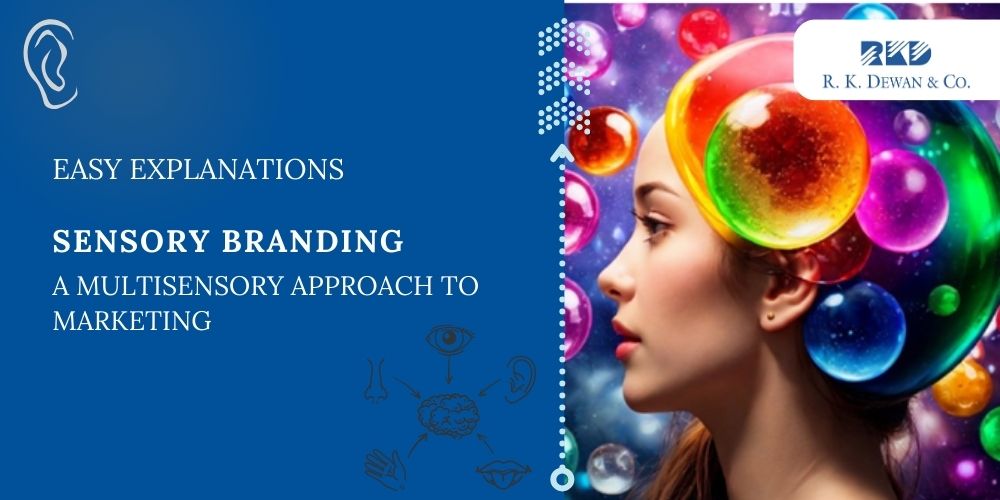Imagine ordering a pizza from a pizza outler, either at their outlet or at home. Along with your pizza, you receive a few extra packets of oregano mix and chilly flakes. These extra packets may seem like a nice gesture, but they’re actually a clever marketing tactic. Whether you’re enjoying your pizza at home or at the outlet, the extra packets are designed to stay with you long after you’ve finished your meal, and every time you use them, you’ll be reminded of Domino’s and crave their pizza again. This is a classic example of sensory branding, where a brand uses sensory experiences to create an emotional connection with its customers.
What is Sensory Branding?
Sensory branding is a marketing technique that involves creating a multisensory experience for customers by stimulating their senses of sight, sound, touch, taste, and smell. This approach aims to create an emotional connection between the customer and the brand, increasing brand loyalty and ultimately driving sales.
Types of Sensory Branding
There are five types of sensory branding, each targeting a specific sense:
Visual Branding
This type of branding involves creating a visual identity for the brand, including logos, colors, and typography. Visual branding is essential in creating a consistent brand image and communicating the brand’s message.
Auditory Branding
Auditory branding involves crafting a unique sonic identity for a brand, encompassing music, sound effects, and voiceovers. By leveraging the emotional resonance of sound, brands can create a lasting impression on customers and make their experience more memorable. A quintessential example of auditory branding in action is the familiar tune played by ice cream vendors, which instantly triggers a sense of excitement and anticipation in children, signaling the arrival of their favorite treats.
Olfactory Branding
Olfactory branding harnesses the power of scents and aromas to create a lasting impression on customers and forge a deep emotional connection with the brand. By carefully selecting and deploying distinct fragrances, businesses can evoke feelings, memories, and associations that linger long after the initial encounter. A prime example of olfactory branding in action is the practice of perfume retailers offering scent samples on strips or testers to passersby, enticing them to explore their fragrances and make a purchase. Similarly, the distinctive aroma of freshly cut grass infused in tennis balls or the warm, inviting scent of cinnamon wafting from dining furniture can transport customers to a specific time and place, creating a rich sensory experience that resonates with the brand’s identity and values.
Gustatory Branding
Gustatory branding involves using taste to create a memorable experience for customers. This type of branding is often used in the food and beverage industry.
Tactile Branding
Tactile branding involves using touch to create a memorable experience for customers. This type of branding can evoke emotions and create a strong association with the brand.
Examples of Sensory Branding
Several brands in India have successfully implemented sensory branding strategies to create a memorable experience for their customers. Here are a few examples:
Local Super Market: Imagine walking into a local super market, and as you enter, you’re greeted by the tantalizing aroma of freshly baked bread. The smell of fresh bread is so appetizing that it makes you want to buy more, and as you shop, you end up buying more than you intended to. This is a clever example of sensory branding, where the smell of fresh bread is used to stimulate your appetite and increase sales.
Street Samosa Shop: The aroma of freshly cooked samosas wafting through the streets is a classic example of olfactory branding. The smell of the samosas creates a craving in the customers, making them want to buy more.
Google Pay Sound: The sound of the Google Pay transaction is a classic example of auditory branding. The sound is designed to be memorable and creates a sense of satisfaction and security for the customers.
Benefits of Sensory Branding
Sensory branding offers several benefits for brands, including:
- Emotional Resonance: Sensory branding can create a deep emotional connection with customers, making them more likely to form a lasting bond with the brand.
- Unique Differentiation: By leveraging the senses, brands can differentiate themselves from competitors and create a distinctive identity that sets them apart.
- Brand Loyalty: Sensory branding can foster loyalty by creating a multisensory experience that customers associate with the brand, making them more likely to return.
- Enhanced Customer Experience: Sensory branding can elevate the customer experience by engaging multiple senses, making it more memorable and enjoyable.
- Brand Recall: Sensory branding can improve brand recall by creating a lasting impression on customers, making it easier for them to remember the brand.
Disadvantages of Sensory Branding
- Sensory Overload: Overwhelming customers with too many sensory stimuli can lead to a negative response and decreased brand loyalty.
- Identity Crisis: Changing sensory branding strategies can confuse existing customers and dilute the brand’s identity.
- Resource Intensive: Developing and implementing effective sensory branding requires significant investments of time, money, and resources.
- Difficulty in Replication: Sensory branding can be challenging to replicate across different touchpoints and channels, which can lead to inconsistent brand experiences.
- Measuring Effectiveness: It can be difficult to measure the effectiveness of sensory branding; making it challenging to justify the investment.Sensory branding is a powerful marketing technique that can create a memorable and emotional experience for customers. By engaging customers’ senses, brands can increase brand recognition, create an emotional connection, differentiate themselves from competitors, and create a memorable experience. Whether it’s through visual, auditory, olfactory, gustatory, or tactile branding, sensory branding is a key part of any marketing strategy.


